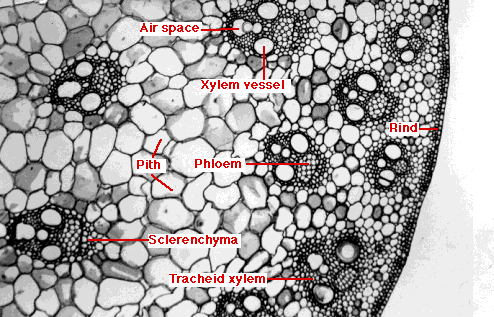The organization of the tissues of the stem differs between dicots and monocots.
The drawing shows a sector of a cross section through a 5-year old twig from a basswood tree (Tilia).
The stem has three areas:

During the growing season, mitosis in this band of meristematic tissue produces new phloem to the outside and new xylem to the inside.
Xylem makes up the wood region.
The xylem vessels made in the spring, when water is plentiful, have larger diameters than those made later in the season. No xylem is made during the dormant season. The visual contrast between the late summer xylem of one season and the spring xylem of the next creates the annual ring.
Xylem serves two functions:
- transport of water and minerals up the stem [Details]
- support.
In older stems only the most recent rings of xylem are active in transport. These make up the sapwood.
The older xylem — the heartwood — support the weight of the tree.
In young stems, the pith, which is made of parenchyma, stores food. The pith disappears in older stems.
 The photograph (courtesy of Turtox) shows the organization of tissues in the corn (maize) stem, a typical monocot. The corn stem consists of:
The photograph (courtesy of Turtox) shows the organization of tissues in the corn (maize) stem, a typical monocot. The corn stem consists of:
- an external rind
- an interior filled with pith.
Vascular bundles are scattered through the pith.
Each vascular bundle contains:
- a layer of sclerenchyma that provides support
- a bundle of phloem containing
- four xylem vessels
- a group of xylem tracheids.
- both carry water and dissolved minerals up the stem.
3 May 2011

 The photograph (courtesy of Turtox) shows the organization of tissues in the corn (maize) stem, a typical monocot. The corn stem consists of:
The photograph (courtesy of Turtox) shows the organization of tissues in the corn (maize) stem, a typical monocot. The corn stem consists of: